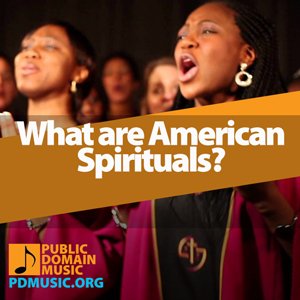 What are American Spirituals?
What are American Spirituals?
Contents [show]
American spirituals are worship songs, hymns, and music written to honor and praise God. Many of these pieces of music are historical and cherished today for not only their message but also their musical brilliance.
American spirituals, also known as Negro spirituals, are a genre of songs that originated in the United States during the period of slavery. Rooted in African musical traditions and the Christian faith, spirituals are poignant expressions of the African American experience, conveying deep emotions and stories through song.
Origins and Historical Context
Spirituals emerged from the fusion of African musical traditions and the Christian hymns introduced by European missionaries.
Slaves in the American South created these songs as a form of resistance and hope amidst the brutal conditions of slavery. They served as a means of communication, spiritual expression, and a source of strength and solidarity.
Characteristics of Spirituals
American spirituals are characterized by their powerful melodies and emotive lyrics. They often feature call-and-response patterns, a prominent element in West African music, and utilize syncopation and improvisation.
The lyrics frequently draw upon biblical themes and stories, interpreting them as metaphors for the slaves’ struggles and aspirations for freedom.
Themes and Symbolism
The themes in spirituals revolve around the harsh realities of slavery, the longing for freedom, and deep religious faith. Songs like “Swing Low, Sweet Chariot” and “Wade in the Water” used biblical imagery as codes for escape and resistance.
The Jordan River, for instance, symbolized the Ohio River or another boundary to freedom, and biblical characters represented figures in the struggle against slavery.
Evolution and Influence
After the Civil War, spirituals evolved, becoming a key part of African American worship services and a foundational element of gospel music.
They also influenced other music genres, including blues and jazz. The Fisk Jubilee Singers, a choir from Fisk University, played a crucial role in bringing spirituals to a broader audience in the late 19th century.
Cultural Significance
American spirituals are a vital part of African American cultural heritage. They represent resilience, hope, and the enduring spirit of a people facing unimaginable hardships.
These songs have been passed down through generations, preserving the history and experiences of African Americans.
Notable Spirituals and Musicians
Some of the most notable spirituals include “Amazing Grace,” “Go Down Moses,” and “Nobody Knows the Trouble I’ve Seen.” Musicians like Mahalia Jackson and Paul Robeson have been instrumental in popularizing spirituals, bringing their profound messages to diverse audiences.
Most Popular American Spirituals
Here’s a list of some of the most well-known American Spirituals and songs through history.
- Ain’ Go’n’ to Study War No Mo’
- Don’t Be Weary, Traveller
- Heave Away
- Go Down Moses
- God’s a-gwine ter move all de troubles away [1918]
- Great Day
- Lord, Remember Me [1867]
- Poor Rosy [1867]
- Rise, Shine, for Thy Light is A-Comin’
- Roll Jordan Roll [1867]
- Some of These Mornings [1892]
- Steal Away to Jesus
- Swing Low, Sweet Chariot
Sacred Harp Music
The Sacred Harp is a book written by Benjamin Franklin White in 1844 that lists some of the most important hymns and songs of worship throughout history. This 572 page book has been revised several times, but is still a wealth of knowledge on the subject of worship music and spirituals.
Here’s a list of several songs from The Sacred Harp.
Spirituals in Contemporary Times
In contemporary times, spirituals continue to be performed and revered for their historical significance and artistic value.
They are often sung in churches, concert halls, and at cultural events, and are studied for their musical, historical, and cultural importance.
Conclusion
American spirituals are a profound expression of the African American experience, woven into the fabric of American history and culture. They stand as a testament to the power of music as a form of expression, resistance, and hope.
As both historical artifacts and living traditions, spirituals continue to resonate with people of all backgrounds, reminding us of the enduring human spirit in the face of adversity.
Frequently Asked Questions
What are American spirituals?
American spirituals are a genre of songs that originated among African American slaves, combining elements of African musical tradition with Christian hymns and themes.
What is the historical significance of American spirituals?
American spirituals are historically significant as they provided a voice and a form of resistance for slaves, expressing their struggles, hopes, and spiritual beliefs.
What themes are commonly found in American spirituals?
Common themes in American spirituals include the hardships of slavery, the longing for freedom, and deep religious faith, often using biblical symbolism.
How did American spirituals influence other music genres?
American spirituals influenced the development of other genres like gospel, blues, and jazz, with their emotive melodies and rhythms.
What are some examples of well-known American spirituals?
Well-known American spirituals include “Swing Low, Sweet Chariot,” “Wade in the Water,” and “Amazing Grace.”
How were American spirituals used during slavery?
During slavery, American spirituals were used as a means of expression, a source of comfort, and sometimes as coded messages for escape and resistance.
What role did American spirituals play in African American churches?
In African American churches, spirituals played a significant role in worship services, embodying the community’s faith and history.
Who were some notable performers of American spirituals?
Notable performers of American spirituals include Mahalia Jackson and Paul Robeson, who helped popularize the genre beyond African American communities.
Are American spirituals still performed today?
Yes, American spirituals are still performed today, often in churches, concerts, and cultural events, celebrated for their historical and musical value.
What is the importance of American spirituals in contemporary culture?
In contemporary culture, American spirituals are important as they preserve a crucial part of African American history and continue to inspire various art forms.
